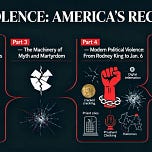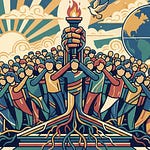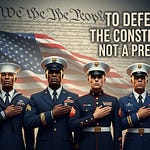
Frame: Guidance for the present.
Why This Moment Demands Us
We have traced America’s long habit of political violence, from mobs silencing abolitionists, to terror during Reconstruction, to the backlash against civil rights, to January 6th. Each chapter reminds us that democracy left unfinished is democracy at risk.
Now we must ask: how do we navigate forward? How do ordinary citizens resist extremism and defend democracy without fueling the violence we seek to stop?
This final installment offers guidance drawn from history, moral traditions of nonviolence, and the practical work of building communities strong enough to resist fear.
Rejecting Apathy: Why Silence = Complicity
Every cycle of violence has been enabled not just by the perpetrators, but by the silence of bystanders.
When Elijah Lovejoy was murdered in 1837 for publishing an abolitionist newspaper, neighboring towns condemned the violence but shrugged at his message. When lynching terrorized Black communities in the early 20th century, most white citizens looked away. On January 6th, many Americans watched in horror but told themselves it was an anomaly, not a warning.
As Holocaust survivor Elie Wiesel wrote: “Neutrality helps the oppressor, never the victim. Silence encourages the tormentor, never the tormented.”
In practice, this means apathy is not neutral. It tips the scales in favor of extremists. Navigating forward begins by refusing to accept silence as an option.
How did you act on January 6th? How deeply did you take this attack on our democracy? If you didn’t understand what was happening, did you seek to find out? Do you carry this with you still?
The Tradition of Nonviolent Resistance
History shows that violence may win a battle, but nonviolence wins movements.
Mahatma Gandhi mobilized millions in India against British colonial rule through marches, boycotts, and strikes — showing that moral force could topple an empire.
Rev. James Lawson and Dr. Martin Luther King Jr. taught and practiced nonviolent direct action in the U.S. Civil Rights Movement. From sit-ins to marches, their discipline exposed the cruelty of segregation while maintaining the moral high ground.
Nelson Mandela, even after decades of imprisonment, rejected vengeance in favor of reconciliation, ensuring South Africa could transition out of apartheid without descending into civil war.
These examples are not romantic gloss. They were pragmatic strategies. Nonviolent resistance works because it denies extremists the chaos they crave. Violence feeds their narrative, while nonviolence disarms it.
As Dr. King said: “Man must evolve for all human conflict a method which rejects revenge, aggression and retaliation. The foundation of such a method is love.”
Guardrails: Law, Literacy, Solidarity
Nonviolence does not mean passivity. It means building guardrails strong enough to prevent violence from prevailing.
1. Law
Laws matter. They set the boundaries of what is tolerated. That’s why voting rights protections, election worker safety, and bans on political intimidation are crucial. Citizens must pressure leaders to pass and enforce these protections, and hold them accountable when they fail.
2. Civic Literacy
Disinformation spreads faster than the truth. A democracy can’t survive if citizens can’t tell the difference. Civic literacy, teaching people how to evaluate information, how propaganda works, and spot manipulation, is as vital as reading and math. Finland’s national media literacy program shows this works: its citizens are the most resistant in Europe to fake news.
3. Solidarity Networks
No one can resist alone. Churches, unions, civic groups, veterans’ halls, and student organizations have always been the backbone of resistance. Solidarity networks provide safety, amplify voices, and prevent individuals from being isolated and targeted.
The lesson: safe resistance requires strong guardrails.
Building a Moral Fusion Coalition
Rev. William Barber often speaks of a “fusion coalition”, a movement that crosses race, class, faith, and generation to unite around moral values. This is how abolitionists built interracial alliances in the 19th century, how suffragists joined with labor organizers in the early 20th century, and how civil rights leaders worked with students, clergy, and even sympathetic officials in the 1960s.
Today, building such a coalition means:
Generational bridges. Seniors are passing on lessons of resilience, and young people are bringing digital skills and urgency.
Cross-racial solidarity. Rejecting divide-and-conquer tactics by insisting that justice for one group strengthens justice for all.
Shared moral ground. It is not left versus right, but proper versus wrong, protecting the vulnerable, resisting lies, and defending dignity.
Movements that succeed do so because they expand the circle of belonging. That is what finishing democracy requires.
Courage Over Fear
Extremism feeds on fear. Fear of change. Fear of losing status. Fear of the “other.” Violence thrives when fear silences courage.
But democracy thrives when ordinary people choose courage.
That courage can be quiet: a teacher correcting lies in a classroom, a neighbor defending an immigrant family, a clerk refusing to falsify election records. It can also be collective: mass marches, boycotts, and town halls that reclaim public space.
The Czech dissident turned president, Vaclav Havel, captured it well: “The real test of a man is not how he behaves in moments of comfort and convenience, but how he stands at times of controversy and challenge.”
Democracy’s survival will not be measured in comfort, but in courage.
Navigating Forward
The path forward is not easy, but it is clear.
Reject apathy: silence is complicity.
Practice nonviolence: it is both moral and strategically practical.
Strengthen guardrails: law, civic literacy, solidarity networks.
Build a fusion coalition: unite across race, class, faith, and age.
Choose courage: fear is the fuel of violence, courage is the lifeblood of democracy.
Closing
Violence has shadowed every expansion of freedom in America. But the story is not finished. The job of democracy can be completed if we navigate forward with clarity and courage.
Violence thrives on fear. Democracy thrives on courage.
The choice is ours.
CTA:
This is the final piece in our six-part series on political violence in America. If this journey has opened your eyes, share it, talk about it, and build with us. Because the work of protecting democracy cannot be outsourced — it belongs to all of us, here and now.
Thanks for reading The Firing Line! Please Subscribe to receive new posts and support our work.
#NavigatingForward #SafeResistance #MoralFusionCoalition #NonviolenceWorks #CourageOverFear #ProtectDemocracy #PoliticalViolence #TheFiringLine #BarkingJusticeMedia











